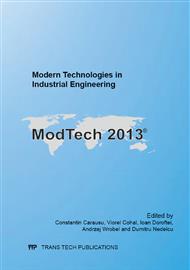[1]
A. Baier and S. Zolkiewski, Initial research of epoxy and polyester matrix laminates testing on abrasive wear used in car sheathing. Eksploatacja i Niezawodnosc – Maintenance and Reliability 15, 1 (2013) 37-43.
Google Scholar
[2]
J. Bijwe, Rekha Rattan and M. Fahim, Abrasive wear performance of carbon fabric reinforced polyetherimide composites: Influence of content and orientation of fabric. Tribology International 40 (2007) 844-854.
DOI: 10.1016/j.triboint.2006.08.005
Google Scholar
[3]
N. S. M. El-Tayeb and B. F. Yousif, Evaluation of glass fiber reinforced polyester composite for multi-pass abrasive wear applications. Wear 262 (2007) 1140-1151.
DOI: 10.1016/j.wear.2006.11.015
Google Scholar
[4]
K. Friedrich, Friction and wear of polymer composites. Composite materials series 1. Amsterdam: Elsevier; (1986).
Google Scholar
[5]
K. H. Z. Gahr, Microstructure and wear of materials. Tribology series 10. Elsevier Science Publishers; (1987).
Google Scholar
[6]
Sandhyarani Biswas and Alok Satapathy, Tribo-performance analysis of red mud filled glass-epoxy composites using Taguchi experimental design. Materials and Design 30 (2009) 2841-2853.
DOI: 10.1016/j.matdes.2009.01.018
Google Scholar
[7]
Thorp J. M. Abrasive wear of some commercial polymers. Tribology International 15 (1982) 89-135.
DOI: 10.1016/0301-679x(82)90054-8
Google Scholar
[8]
Xie You-Bai, On the tribology design. Tribology International 32, (1999) 351-358.
Google Scholar
[9]
B. Surowska, Functional and hybrid materials in air transport, Eksploatacja i Niezawodnosc – Maintenance and Reliability 3 (2008) 30-40.
Google Scholar
[10]
S. Zolkiewski, Selection and impact of parameters in designing of composite materials. 13th World Congress in Mechanism and Machine Science, Guanajuato, México, 19-25 June, (2011), A23_555: 1-10.
Google Scholar
[11]
S. Zolkiewski, Testing of Fibreglass-Metal Laminates in Epoxy Matrix Connected by Means of the Adhesive Layer, Solid State Phenomena, Mechatronic Systems and Materials V 199 (2013) 599-606.
DOI: 10.4028/www.scientific.net/ssp.199.599
Google Scholar
[12]
S. Zolkiewski, Mechanical properties of hybrid composites made of a steel plate and a laminate connected by means of barbed studs, PAMM _ Proc. Appl. Math. Mech. / DOI 10. 1002/pamm. 201210072, 12 (2012) 163-164.
DOI: 10.1002/pamm.201210072
Google Scholar
[13]
S. Zolkiewski, Dynamic flexibility of the supported-clamped beam in transportation, Journal of Vibroengineering, 13, 4 (2011) 810-816.
Google Scholar
[14]
S. Zolkiewski, Testing composite materials connected in bolt joints. Journal of Vibroengineering, 13, 4 (2011) 817-822.
Google Scholar
[15]
S. Zolkiewski, Abrasive wear of the fibreglass laminate made of polyester. Международная научно-техническая конференция Машиностроительные технологии и техника автоматизации - 2012, ГИУA Ереван 2012, 44-47.
Google Scholar
[16]
S. Zolkiewski, Abrasive tests, in: A. Buchacz, A. Baier, J. Świder (Eds. ), Experimental Tests of Chosen Fibre-Metal Laminates, Silesian Univeristy of Technology Press, Gliwice (2012), 21, 44-56.
Google Scholar
[17]
A. Buchacz and M. Płaczek, Development of Mathematical Model of a Mechatronic System, Solid State Phenomena 164 (2010) 319-322.
DOI: 10.4028/www.scientific.net/ssp.164.319
Google Scholar
[18]
A. Buchacz and M. Płaczek, Selection of Parameters of External Electric Circuit for Control of Dynamic Flexibility of a Mechatronic System, Solid State Phenomena 164 (2010) 323-326.
DOI: 10.4028/www.scientific.net/ssp.164.323
Google Scholar
[19]
A. Dobrzańska-Danikiewicz, Foresight methods for technology validation, roadmapping and development in the surface engineering area, Archives of Materials Science Engineering 44, 2 (2010) 69-86.
Google Scholar
[20]
C. Grabowik and K Kalinowski, Object-Oriented Models in an Integration of CAD/CAPP/CAP Systems. Hybrid Artificial Intelligent Systems, Part II Book Series: Lecture Notes in Artificial Intelligence, 6679 (2011) 405-412.
DOI: 10.1007/978-3-642-21222-2_49
Google Scholar
[21]
A. Baier and M. Majzner, Application of feature method to the modeling of composite structural elements, Journal of Achievements in Materials and Manufacturing Engineering 45, 1 (2011) 30-38.
Google Scholar
[22]
A. Baier and M. Majzner, Analysis of composite structural elements, Journal of Achievements in Materials and Manufacturing Engineering 43, 2 (2010) 577-585.
Google Scholar
[23]
S. Zolkiewski, Attenuation-frequency Characteristics of Beam Systems in Spatial Motion, Solid State Phenomena 164 (2010) 349-354.
DOI: 10.4028/www.scientific.net/ssp.164.349
Google Scholar
[24]
S. Zolkiewski, Numerical Application for Dynamical Analysis of Rod and Beam Systems in Transportation, Solid State Phenomena 164 (2010) 343-348.
DOI: 10.4028/www.scientific.net/ssp.164.343
Google Scholar
[25]
S. Zolkiewski, Dynamical Flexibility of Complex Damped Systems Vibrating Transversally in Transportation, Solid State Phenomena 164 (2010) 339-342.
DOI: 10.4028/www.scientific.net/ssp.164.339
Google Scholar
[26]
A. Dobrzańska-Danikiewicz, Foresight of material surface engineering as a tool building a knowledge-based economy, Materials Science Forum 706-709 (2012) 2511-2516.
DOI: 10.4028/www.scientific.net/msf.706-709.2511
Google Scholar


